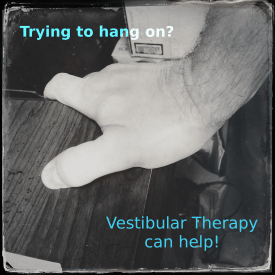Migraine Treatment: Vestibular Rehabilitation
If you suffer from dizziness, vertigo, or a feeling of imbalance, you might benefit from vestibular rehabilitation. Vestibular rehab will probably be a part of your overall treatment if you have dizziness or similar symptoms as a part of your migraine disease.
The word “vestibular” in this case refers to issues relating to balance, in particular related to the inner ear. But that doesn’t mean that there needs to be a structural problem – or anything visible at all, that is causing balance problems.
Vestibular symptoms can extend beyond just dizziness and/or vertigo, to include:
- nausea
- visual disturbances
- headaches
- neck stiffness/pain
- anxiety/depression
So what does vestibular rehabilitation involve?
This is one of many helpful migraine-related treatments that can be given by a physiotherapist. Vestibular rehabilitation therapy involves specific exercises depending on your condition and medical history.
For example, if your doctor has identified an actual inner ear issue, some exercises will help to counter that problem. If you experience more dizziness when you’re moving around, certain exercises will help with that.
Sometimes treatments are categorized in three groups: habituation (treating problems related to motion or visual stimuli), gaze stabilization (treating problems related to eye movement, or to compensate for other problems), and balance training (improving general steadiness).
Some exercises may actually help to “heal” your condition. But many vestibular problems are permanent. So many exercises can actually counteract the problem, or compensate for one deficiency by using other senses.
Because the exercise program can be so complex (though not difficult) and based on your specific condition, medical history, and even family history, it is best to see an expert rather than just doing a search on YouTube.
However, if you have already been diagnosed and discussed your condition with a condition, there are some basic exercises that may help. Be sure your doctor has checked to rule out other treatable causes of your symptoms, and that you’ve discussed the exercises with her.
If your exercises make your dizziness continually worse, you encounter hearing problems or a feeling of ear fullness/pain, or you have significant back/neck pain, stop the exercises and see your doctor right away.
For more information, including exercises to try, check out:
- Vestibular Rehabilitation (pdf) from the Vestibular Disorders Association (USA)
- Dizziness and balance problems (pdf) from the Brain & Spine Foundation, including information, exercises, and resources in the UK and USA.
- What Is Balance and Vestibular Rehabilitation Therapy? from Brainline.org, with exercises and information.
Vestibular therapy can be an important part of your migraine treatment. If these types of problems are ignored, other treatments may be less effective. It will be harder to be mobile, to eat properly, and to have a generally improved quality of life.
If you suffer from imbalance, talk to your doctor. There are good treatments available.
For more information:
- Whirled Foundation (Australia)
- Vestibular Rehabilitation Therapy (VRT)
- Vestibular Rehabilitation (for health professionals)
- Vestibular Migraine – Why the confusion?
- What is Migraine Associated Vertigo? (graphic introduction)
